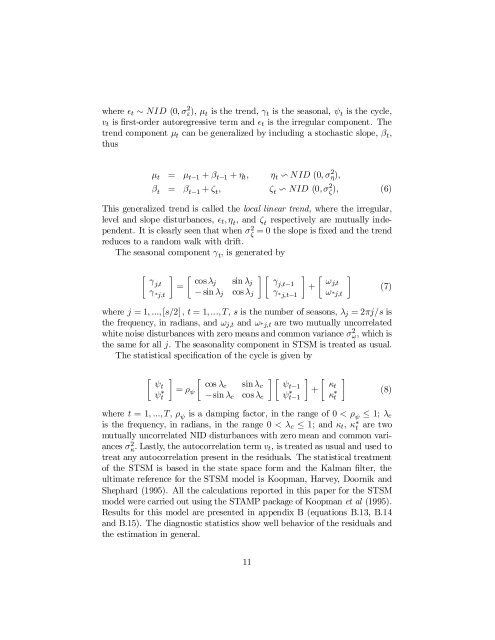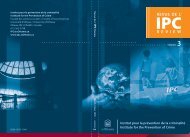0306E - Faculty of Social Sciences - Université d'Ottawa
0306E - Faculty of Social Sciences - Université d'Ottawa
0306E - Faculty of Social Sciences - Université d'Ottawa
Create successful ePaper yourself
Turn your PDF publications into a flip-book with our unique Google optimized e-Paper software.
where ² t » NID (0; ¾ 2 "); ¹ t is the trend, ° t is the seasonal, Ã t is the cycle,<br />
v t is …rst-order autoregressive term and ² t is the irregular component. The<br />
trend component ¹ t can be generalized by including a stochastic slope, ¯t,<br />
thus<br />
¹ t = ¹ t¡1 + ¯t¡1 + ´t; ´t v N ID (0; ¾ 2´);<br />
¯t = ¯t¡1 + ³ t ; ³ t v NID (0; ¾ 2 ³ ); (6)<br />
This generalized trend is called the local linear trend, where the irregular,<br />
level and slope disturbances, ² t ; ´t; and ³ t respectively are mutually independent.<br />
It is clearly seen that when ¾ 2 ³<br />
= 0 the slope is …xed and the trend<br />
reduces to a random walk with drift.<br />
The seasonal component ° t ; is generated by<br />
·<br />
°j;t<br />
° ¤ j;t<br />
¸ · cos<br />
=<br />
¸j sin ¸j<br />
¡ sin ¸j cos ¸j<br />
¸ ·<br />
°j;t¡1<br />
°¤ j;t¡1<br />
¸ ·<br />
!j;t<br />
+<br />
!¤ j;t<br />
¸<br />
(7)<br />
where j = 1; :::; [s=2] ; t = 1; :::; T; s is the number <strong>of</strong> seasons, ¸j = 2¼j=s is<br />
the frequency, in radians, and ! j;t and !¤ j;t are two mutually uncorrelated<br />
white noise disturbances with zero means and common variance ¾ 2 !; which is<br />
the same for all j. The seasonality component in STSM is treated as usual.<br />
The statistical speci…cation <strong>of</strong> the cycle is given by<br />
·<br />
Ãt<br />
à ¤ t<br />
¸<br />
· cos<br />
= ½<br />
¸c sin¸c<br />
Ã<br />
¡sin ¸c cos ¸c<br />
¸ ·<br />
Ãt¡1<br />
à ¤ t¡1<br />
¸ ·<br />
+<br />
·t<br />
·¤t<br />
¸<br />
(8)<br />
where t = 1; :::; T; ½ Ã is a damping factor, in the range <strong>of</strong> 0 < ½ Ã · 1; ¸c<br />
is the frequency, in radians, in the range 0 < ¸c · 1; and ·t; ·¤t<br />
are two<br />
mutually uncorrelated NID disturbances with zero mean and common variances<br />
¾ 2·: Lastly, the autocorrelation term v t, is treated as usual and used to<br />
treat any autocorrelation present in the residuals. The statistical treatment<br />
<strong>of</strong> the STSM is based in the state space form and the Kalman …lter, the<br />
ultimate reference for the STSM model is Koopman, Harvey, Doornik and<br />
Shephard (1995). All the calculations reported in this paper for the STSM<br />
model were carried out using the STAMP package <strong>of</strong> Koopman et al (1995).<br />
Results for this model are presented in appendix B (equations B.13, B.14<br />
and B.15). The diagnostic statistics show well behavior <strong>of</strong> the residuals and<br />
the estimation in general.<br />
11
















